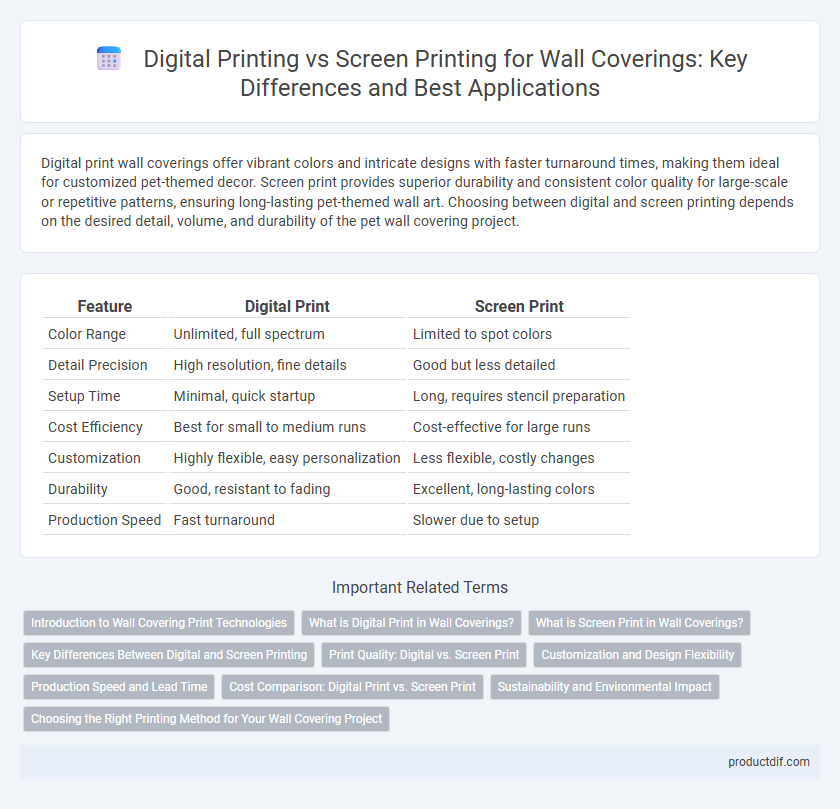Digital print wall coverings offer vibrant colors and intricate designs with faster turnaround times, making them ideal for customized pet-themed decor. Screen print provides superior durability and consistent color quality for large-scale or repetitive patterns, ensuring long-lasting pet-themed wall art. Choosing between digital and screen printing depends on the desired detail, volume, and durability of the pet wall covering project.
Table of Comparison
| Feature | Digital Print | Screen Print |
|---|---|---|
| Color Range | Unlimited, full spectrum | Limited to spot colors |
| Detail Precision | High resolution, fine details | Good but less detailed |
| Setup Time | Minimal, quick startup | Long, requires stencil preparation |
| Cost Efficiency | Best for small to medium runs | Cost-effective for large runs |
| Customization | Highly flexible, easy personalization | Less flexible, costly changes |
| Durability | Good, resistant to fading | Excellent, long-lasting colors |
| Production Speed | Fast turnaround | Slower due to setup |
Introduction to Wall Covering Print Technologies
Digital print technology offers high-resolution, customizable designs ideal for intricate wall coverings, enabling quick production with vibrant color accuracy. Screen print, a traditional method, excels in durability and uniformity for large-scale runs but requires more setup time and limited color variation. Choosing between digital and screen print depends on project scale, design complexity, and budget constraints.
What is Digital Print in Wall Coverings?
Digital print in wall coverings uses advanced inkjet technology to apply high-resolution, full-color images directly onto various wall surfaces. This method allows for limitless design customization, including intricate patterns and photographic quality details, making it ideal for personalized and complex wall decor. Digital print offers faster production times and reduced setup costs compared to traditional screen printing, enhancing efficiency for both commercial and residential projects.
What is Screen Print in Wall Coverings?
Screen printing in wall coverings is a traditional technique where ink is pushed through a mesh stencil onto the wall surface, creating bold and vibrant patterns with precise color layering. This method offers durability and texture, making it ideal for high-traffic areas requiring long-lasting designs. Screen print allows for rich color saturation and tactile finishes that digital printing may not replicate effectively.
Key Differences Between Digital and Screen Printing
Digital print offers high-resolution imagery with unlimited color options, ideal for complex wall covering designs and short production runs. Screen printing excels in producing vibrant, durable colors with thick ink layers, making it suitable for large batches and textured surfaces. Key differences include digital printing's flexibility and speed versus screen printing's cost-effectiveness for volume and tactile finish quality.
Print Quality: Digital vs. Screen Print
Digital print offers high-resolution detail with a wide color spectrum and smooth gradients, making it ideal for intricate wall covering designs. Screen print provides vibrant, opaque colors with excellent durability but may lack the fine detail achievable through digital printing. The choice depends on design complexity and desired color vibrancy in wall coverings.
Customization and Design Flexibility
Digital print offers unparalleled customization and design flexibility for wall coverings, enabling intricate, full-color images and rapid design changes without additional setup costs. Screen printing involves higher setup costs and is best suited for repetitive patterns with limited color palettes, making it less adaptable for highly detailed or personalized designs. The choice hinges on project scale and the need for unique, complex visuals versus traditional, consistent motifs.
Production Speed and Lead Time
Digital print technology offers significantly faster production speed and shorter lead times compared to screen print methods, enabling rapid turnaround for wall covering projects. Screen printing requires time-intensive setup for each design, which prolongs overall production and delays delivery. Choosing digital print streamlines manufacturing, making it ideal for quick, customized wall covering orders.
Cost Comparison: Digital Print vs. Screen Print
Digital print offers a lower initial setup cost compared to screen print, making it more affordable for small to medium-sized wall covering projects. Screen print involves higher fixed expenses due to stencil creation and longer production runs, which reduces cost per unit only at large volumes. For customized, short-run wall coverings, digital print is the cost-efficient choice, while screen print excels in bulk orders with consistent designs.
Sustainability and Environmental Impact
Digital print wall coverings significantly reduce waste by using precise ink application and eliminating the need for screens, lowering water consumption compared to traditional screen printing processes. Screen printing typically involves higher energy use and generates more chemical waste, making it less environmentally friendly for large-scale production. Sustainable digital printing technologies incorporate eco-friendly inks and recyclable substrates, enhancing its appeal for green building projects and reducing overall carbon footprints.
Choosing the Right Printing Method for Your Wall Covering Project
Digital print offers high-resolution images with unlimited color options, ideal for intricate wall covering designs and short to medium runs. Screen print excels in durability and vibrancy for large volumes, providing cost-effective solutions with solid color coverage. Selecting the right printing method depends on project scale, design complexity, budget, and desired finish.
Digital Print vs Screen Print Infographic

 productdif.com
productdif.com